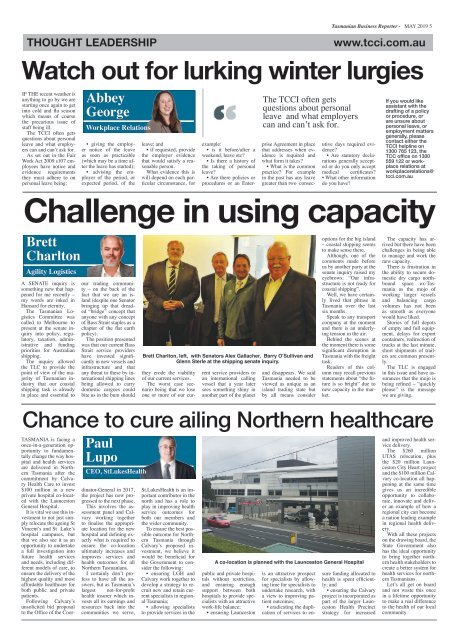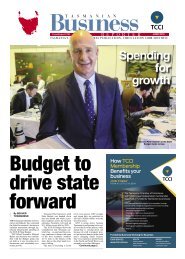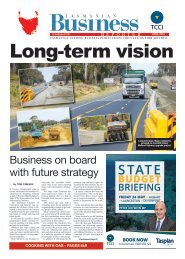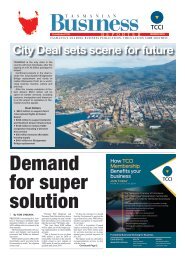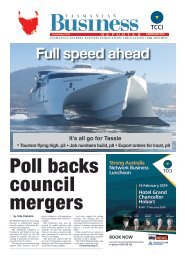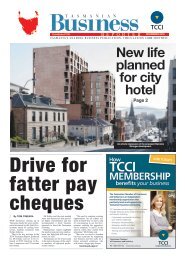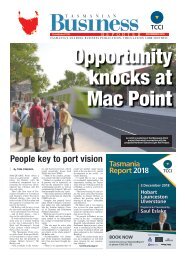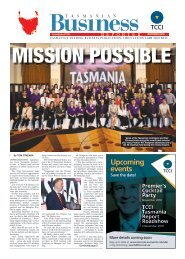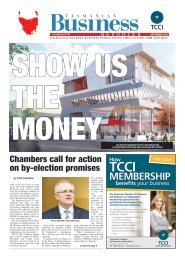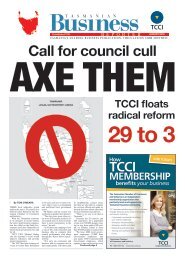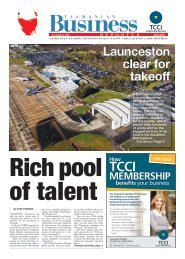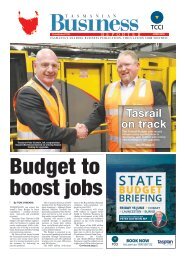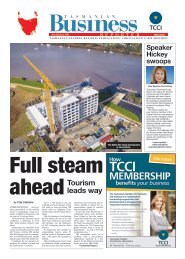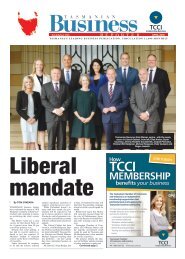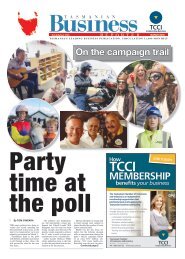Tasmanian Business Reporter May 2019
Welcome to the May edition of the TBR. This month we bring you an in-depth preview into what to expect from the upcoming 2019 State Budget, where record spending is expected to continue in health, education, housing and infrastructure despite significant decreases in stamp duty and GST payments contributing to a hit to State revenue. You'll also find an explanation of the franking credits issue from Tasplan Super CEO Wayne Davy, details of a new WorkSafe Tasmania workplace mental health awareness campaign (click here to watch their video), as well as all the latest business news from across the state.
Welcome to the May edition of the TBR.
This month we bring you an in-depth preview into what to expect from the upcoming 2019 State Budget, where record spending is expected to continue in health, education, housing and infrastructure despite significant decreases in stamp duty and GST payments contributing to a hit to State revenue.
You'll also find an explanation of the franking credits issue from Tasplan Super CEO Wayne Davy, details of a new WorkSafe Tasmania workplace mental health awareness campaign (click here to watch their video), as well as all the latest business news from across the state.
You also want an ePaper? Increase the reach of your titles
YUMPU automatically turns print PDFs into web optimized ePapers that Google loves.
<strong>Tasmanian</strong> <strong>Business</strong> <strong>Reporter</strong> - MAY <strong>2019</strong> 5<br />
THOUGHT LEADERSHIP<br />
www.tcci.com.au<br />
Watch out for lurking winter lurgies<br />
IF THE recent weather is<br />
anything to go by we are<br />
starting once again to get<br />
into cold and flu season<br />
which means of course<br />
the precarious issue of<br />
staff being ill.<br />
The TCCI often gets<br />
questions about personal<br />
leave and what employers<br />
can and can’t ask for.<br />
As set out in the Fair<br />
Work Act 2009 s107 employees<br />
have notice and<br />
evidence requirements<br />
they must adhere to on<br />
personal leave being:<br />
Abbey<br />
George<br />
Workplace Relations<br />
• giving the employer<br />
notice of the leave<br />
as soon as practicable<br />
(which may be a time after<br />
the leave has started);<br />
• advising the employer<br />
of the period, or<br />
expected period, of the<br />
leave; and<br />
• if requested, provide<br />
the employer evidence<br />
that would satisfy a reasonable<br />
person.<br />
What evidence this is<br />
will depend on each particular<br />
circumstance, for<br />
The TCCI often gets<br />
questions about personal<br />
leave and what employers<br />
can and can’t ask for.<br />
example:<br />
• is it before/after a<br />
weekend, leave etc?<br />
• Is there a history of<br />
the taking of personal<br />
leave?<br />
• Are there policies or<br />
procedures or an Enterprise<br />
Agreement in place<br />
that addresses when evidence<br />
is required and<br />
what form it takes?<br />
• What is the common<br />
practice? For example<br />
in the past has any leave<br />
greater than two consecutive<br />
days required evidence?<br />
• Are statutory declarations<br />
generally accepted<br />
or do you only accept<br />
medical certificates?<br />
• What other information<br />
do you have?<br />
If you would like<br />
assistant with the<br />
drafting of a policy<br />
or procedure, or<br />
are unsure about<br />
personal leave, or<br />
employment matters<br />
generally, please<br />
contact either the<br />
TCCI helpline on<br />
1300 765 123, the<br />
TCC office on 1300<br />
559 122 or workplace<br />
relations at<br />
workplacerelations@<br />
tcci.com.au<br />
Challenge in using capacity<br />
Brett<br />
Charlton<br />
Agility Logistics<br />
A SENATE inquiry is<br />
something new that happened<br />
for me recently –<br />
my words are inked in<br />
Hansard for eternity.<br />
The <strong>Tasmanian</strong> Logistics<br />
Committee was<br />
called to Melbourne to<br />
present at the senate inquiry<br />
into policy, regulatory,<br />
taxation, administrative<br />
and funding<br />
priorities for Australian<br />
shipping.<br />
The inquiry allowed<br />
the TLC to provide the<br />
point of view of the majority<br />
of <strong>Tasmanian</strong> industry<br />
that our coastal<br />
shipping task is already<br />
in place and essential to<br />
our trading community<br />
– on the back of the<br />
fact that we are an island<br />
(despite one Senator<br />
bringing up that dreaded<br />
“bridge” concept that<br />
anyone with any concept<br />
of Bass Strait staples as a<br />
chapter of the flat earth<br />
policy).<br />
The position presented<br />
was that our current Bass<br />
Strait service providers<br />
have invested significantly<br />
in new vessels and<br />
infrastructure and that<br />
any threat to these by international<br />
shipping lines<br />
being allowed to carry<br />
domestic cargoes could<br />
bite us in the bum should<br />
Brett Charlton, left, with Senators Alex Gallacher, Barry O’Sullivan and<br />
Glenn Sterle at the shipping senate inquiry.<br />
they erode the viability<br />
of our current services.<br />
The worst case scenario<br />
being that we lose<br />
one or more of our current<br />
service providers to<br />
an international calling<br />
vessel that a year later<br />
sees something shiny in<br />
another part of the planet<br />
and disappears. We said<br />
Tasmania needed to be<br />
viewed as unique as an<br />
island trading state but<br />
by all means consider<br />
options for the big island<br />
– coastal shipping seems<br />
to make sense there.<br />
Although, one of the<br />
comments made before<br />
us by another party at the<br />
senate inquiry raised my<br />
eyebrows: “Our infrastructure<br />
is not ready for<br />
coastal shipping”.<br />
Well, we have certainly<br />
lived that phrase in<br />
Tasmania over the last<br />
six months.<br />
Speak to any transport<br />
company at the moment<br />
and there is an underlying<br />
tension in the air.<br />
Behind the scenes at<br />
the moment there is some<br />
significant disruption in<br />
Tasmania with the freight<br />
task.<br />
Readers of this column<br />
may recall previous<br />
statements about “the future<br />
is so bright” due to<br />
new capacity in the market.<br />
The capacity has arrived<br />
but there have been<br />
challenges in being able<br />
to manage and work the<br />
new capacity.<br />
There is frustration in<br />
the ability to secure domestic<br />
dry cargo northbound<br />
space ex-Tasmania<br />
as the mojo of<br />
working larger vessels<br />
and balancing cargo<br />
volumes has not been<br />
as smooth as everyone<br />
would have liked.<br />
Stories of full depots<br />
of empty and full equipment,<br />
delays for export<br />
containers, redirection of<br />
trucks at the last minute,<br />
short shipments of trailers<br />
are common presently.<br />
The TLC is engaged<br />
in this issue and have assurances<br />
that the mojo is<br />
being refined – “quickly<br />
please” is the message<br />
we are giving.<br />
Chance to cure ailing Northern healthcare<br />
Paul<br />
Lupo<br />
CEO, StLukesHealth<br />
TASMANIA is facing a<br />
once-in-a-generation opportunity<br />
to fundamentally<br />
change the way hospital<br />
and health services<br />
are delivered in Northern<br />
Tasmania after the<br />
commitment by Calvary<br />
Health Care to invest<br />
$100 million in a new<br />
private hospital co-located<br />
with the Launceston<br />
General Hospital.<br />
It is vital we use this investment<br />
to not just simply<br />
relocate the ageing St<br />
Vincent’s and St Luke’s<br />
hospital campuses, but<br />
that we also see it as an<br />
opportunity to undertake<br />
a full investigation into<br />
future health services<br />
and needs, including different<br />
models of care, to<br />
ensure the delivery of the<br />
highest quality and most<br />
affordable healthcare for<br />
both public and private<br />
patients.<br />
Following Calvary’s<br />
unsolicited bid proposal<br />
to the Office of the Coordinator-General<br />
in 2017,<br />
the project has now progressed<br />
to the next phase.<br />
This involves the assessment<br />
panel and Calvary<br />
working together<br />
to finalise the appropriate<br />
location for the new<br />
hospital and defining exactly<br />
what is required to<br />
ensure the co-location<br />
ultimately increases and<br />
improves services and<br />
health outcomes for all<br />
Northern <strong>Tasmanian</strong>s.<br />
I certainly don’t profess<br />
to have all the answers,<br />
but as Tasmania’s<br />
largest not-for-profit<br />
health insurer which invests<br />
all its earnings and<br />
resources back into the<br />
communities we serve,<br />
St.LukesHealth is an important<br />
contributor in the<br />
north and has a role to<br />
play in improving health<br />
service outcomes for<br />
both our members and<br />
the wider community.<br />
To ensure the best possible<br />
outcome for Northern<br />
Tasmania through<br />
Calvary’s proposed investment,<br />
we believe it<br />
would be beneficial for<br />
the Government to consider<br />
the following:<br />
• ensuring LGH and<br />
Calvary work together to<br />
develop a strategy to recruit<br />
new and retain current<br />
specialists in regional<br />
Tasmania;<br />
• allowing specialists<br />
to provide services in the<br />
A co-location is planned with the Launceston General Hospital<br />
public and private hospitals<br />
without restriction,<br />
and ensuring enough<br />
support between both<br />
hospitals to provide specialists<br />
with an attractive<br />
work-life balance;<br />
• ensuring Launceston<br />
is an attractive prospect<br />
for specialists by allowing<br />
time for specialists to<br />
undertake research, with<br />
a view to improving patient<br />
outcomes;<br />
• eradicating the duplication<br />
of services to ensure<br />
funding allocated to<br />
health is spent efficiently;<br />
and<br />
• ensuring the Calvary<br />
project is incorporated as<br />
part of the larger Launceston<br />
Health Precinct<br />
strategy for increased<br />
and improved health service<br />
delivery.<br />
The $260 million<br />
UTAS relocation, plus<br />
the $20 million Launceston<br />
City Heart project<br />
and the $100 million Calvary<br />
co-location all happening<br />
at the same time<br />
gives us an incredible<br />
opportunity to collaborate,<br />
innovate and deliver<br />
an example of how a<br />
regional city can become<br />
a nation leading example<br />
in regional health delivery.<br />
With all these projects<br />
on the drawing board, the<br />
State Government also<br />
has the ideal opportunity<br />
to bring together northern<br />
health stakeholders to<br />
create a better system for<br />
health services for northern<br />
<strong>Tasmanian</strong>s.<br />
Let’s all get on board<br />
and not waste this once<br />
in a lifetime opportunity<br />
to make a real difference<br />
to the health of our local<br />
community.


